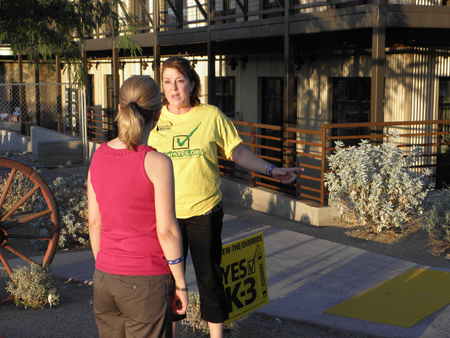CCUSD only cut 1.5 percent from M&O budget
By Linda Bentley | October 7, 2009
 The Learn YES Political Action Committee regarded The Taste of Cave Creek event as an opportunity to campaign for the school district’s K-3 override. Volunteers advocating passage of the override had a table set up at the entrance and erected campaign signs throughout the parking lot, although numerous attendees considered the venue inappropriate for political activism. Photo by Linda Bentley
The Learn YES Political Action Committee regarded The Taste of Cave Creek event as an opportunity to campaign for the school district’s K-3 override. Volunteers advocating passage of the override had a table set up at the entrance and erected campaign signs throughout the parking lot, although numerous attendees considered the venue inappropriate for political activism. Photo by Linda Bentley
The override the district currently seeks to ‘renew’ still has two more years of funding
CCUSD – When money’s tight, people make sacrifices and sort out their priorities. Government, on the other hand, often takes a different approach.
The city of Phoenix, for example, when faced with a need to cut its budget, uses the across-the-board approach, leaving all the excesses in place with perhaps a cut to their office supplies, while slashing public safety funding, where it knows taxpayers have traditionally footed the bill by paying more taxes.
Cave Creek’s leadership did what needed to be done by laying off workers, shortening the work week and making cuts everywhere it could without compromising citizens’ safety or services.
School districts are a different story altogether. School finances are comprised of a convoluted mass of formulas based on incomprehensible statutes.
However, even without knowing how it is calculated, school districts still provide a bottom line.
Cave Creek Unified School District has threatened eliminating teachers and increasing class sizes if its ongoing request for a K-3 budget override doesn’t pass.
However, according to the district’s 2009/2010 budget, the district has “slashed” an aggregate total of 1.5 percent from its Maintenance and Operation (M&O) budget and still reflects an 18:1 student to teacher ratio.
Meanwhile, district taxpayers have received their property tax bills and most reflect the Full Cash Value (Secondary) down over last year’s valuation, the Limited Property Value (Primary) up and the moratorium on the equalization tax expired, resulting in a property tax bill, in many instances, about 10 percent higher than last year’s tax bill.
CCUSD has gone from an M&O budget of $35.7 million to an M&O budget of $35.1 million.
Classroom instruction saw an overall increase of 1.2 percent, instructional staff in the “other” category increased by 3.2 percent.
The district reduced administration expenses by 2.1 percent while slashing school-sponsored athletics by 61.7 percent and school-sponsored co-curricular activities by 100 percent, even though those budget items make up a miniscule portion of the overall budget.
Only 60 parents participated in the Step Up! program, proposed by a group of parents to help combat the impending colossal budget cuts the district said might occur, and donated a total of $17,375 in tax-deductible contributions to the district.
Considering there are fewer than 5,900 students in the district, their efforts average less than $3 per student.
It should be noted the district has also decided to accept stimulus funds from the federal government, which means there are strings attached. The strings attached to the bulk of the two-year stimulus money are the district use the money to create new programs and explain how those new programs will be funded after the stimulus funds run out.
CCUSD also receives funds from the federal No Child Left Behind (NCLB) program, which requires schools and districts meet Average Yearly Progress (AYP) goals based on more convoluted formulas through AZ LEARNS. It is also the program which gives all eight of CCUSD’s schools their “excelling” labels, although the district, as a whole, somehow failed to meet AYP goals.
CCUSD taxpayers should also be reminded they’ve been paying off $15 million in bonds (over $50,000 per month in interest alone) issued in September 2006 to build a new high school that the district is not building, in violation of IRS rules governing tax-free bonds.
The district is still receiving state funding for all-day kindergarten, which is what taxpayers were told the original K-3 override was supposed to fund when it was narrowly passed by voters in 2005.
That means the district is still double-dipping for all-day kindergarten.
And last, the override the district currently seeks to “renew” still has two more years of funding, although it will be reduced by one third for each of the next two years.
